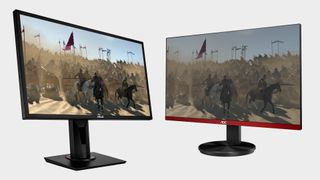3D-printed bendable OLEDs could one day mean cheaper OLED gaming monitors
If manufacturers can pull this new method off, it'll cut a bunch of costs.
The manufacturing process for OLED displays is currently less than optimal, involving vast factories, convoluted machinery, and a perfectly dust-free environment. But what if we could just 3D print an OLED panel?
That's what researchers at the University of Minnesota Twin Cities have produced: the world's first bendable, fully 3D printed OLED screen. Sure it's only 1.5 inches, and 64 pixels in total, but it's a start. Brought to our attention by Hardware Info, this is the kind of advancement that could easily bring cheaper, more efficient production to the world of TV's and gaming monitors, as well as laptop and phone screens.
The research is published in the peer-reviewed Science Advances journal, where the abstract outlines more intricacies of the screen's 'hybrid design.'
"The electrodes, interconnects, insulation, and encapsulation are all extrusion-printed, while the active layers are spray-printed. Spray printing leads to improved layer uniformity via suppression of directional mass transport in the printed droplets.
"By exploiting the viscoelastic oxide surface of the printed cathode droplets, a mechanical reconfiguration process is achieved to increase the contact area of the polymer-metal junctions. The uniform cathode array is intimately interfaced with the top interconnects."
To achieve this incredible feat, the team used a custom tabletop 3D printer, which "was custom built and costs about the same as a Tesla Model S," says the study's senior author Michael McAlpine, a University of Minnesota Kuhrmeyer Family Chair Professor in the Department of Mechanical Engineering.

Best gaming monitor: pixel-perfect panels for your PC
Best high refresh rate monitor: screaming quick screens
Best 4K monitor for gaming: when only high-res will do
Best 4K TV for gaming: big-screen 4K PC gaming
According to The Engineer, previous attempts had been made to 3D print OLED displays, but the crucial uniformity of light emitting layers was a massive hurdle for the team. Others were able to print some components, but remained reliant on the current standards of spin-coating or thermal evaporation to finish the displays off.
The biggest gaming news, reviews and hardware deals
Keep up to date with the most important stories and the best deals, as picked by the PC Gamer team.
Ruitao Su, another of the study's authors and postdoctoral researcher at MIT, talked up the flexibility of the display. They note that it was able to keep "a relatively stable emission over the 2,000 bending cycles, suggesting that fully 3D printed OLEDs can potentially be used for important applications in soft electronics and wearable devices."
From here, the team intends to increase the pixel density (obviously) and the brightness until the technology is ready to hit consumer electronics. If all goes to plan, budget-friendly 4K OLED gaming monitors could be just a few steps away.

Screw sports, Katie would rather watch Intel, AMD and Nvidia go at it. Having been obsessed with computers and graphics for three long decades, she took Game Art and Design up to Masters level at uni, and has been rambling about games, tech and science—rather sarcastically—for four years since. She can be found admiring technological advancements, scrambling for scintillating Raspberry Pi projects, preaching cybersecurity awareness, sighing over semiconductors, and gawping at the latest GPU upgrades. Right now she's waiting patiently for her chance to upload her consciousness into the cloud.
Most Popular






